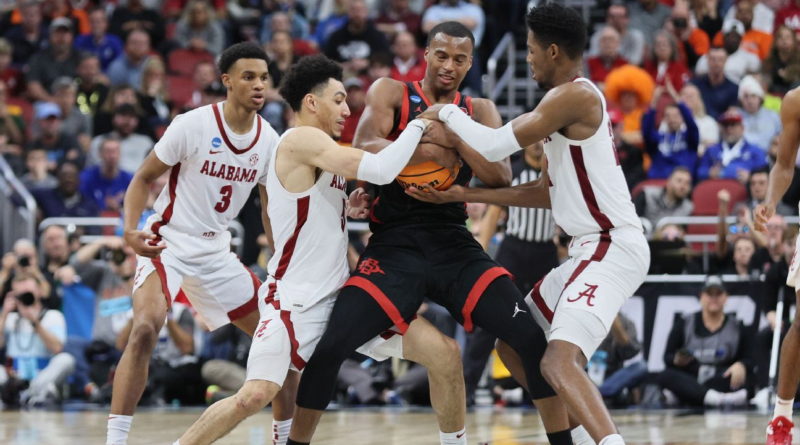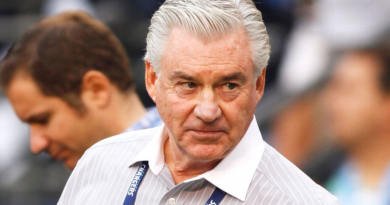No. 1 and done: No Kansas, Purdue, Alabama, Houston in the Elite Eight
Perhaps we should have seen this sort of NCAA tournament coming, especially after a 16-seed and 15-seed advanced out of the first round for the first time in history. It’s only become more wild since Fairleigh Dickinson and Princeton won their opening games. For the first time in NCAA tournament history, there won’t be a single 1-seed in the Elite Eight — or the Final Four. Regardless of Texas‘ outcome against Xavier on Friday night, there will also be the fewest number of top-two seeds in the Elite Eight since seeding began.
Alabama losing to San Diego State and Houston getting blown out by Miami made it official: This is the most unpredictable NCAA tournament we’ve ever seen.
How did we get here? Why is it happening? ESPN’s men’s college basketball experts Jeff Borzello, John Gasaway, Joe Lunardi and Myron Medcalf break it down.
What can we conclude about all the 1-seeds being out before the Elite Eight?
Joe Lunardi: Let the overreactions begin. The first rule of thumb in March is that virtually any team — A-N-Y T-E-A-M! — can win a 40-minute game played by college kids. That said, the number of shockers in the last two weekends is equal parts mind-numbing (for the losers) and awe-inspiring (for the rest of us). This year’s outcome, with all No. 1 seeds gone by the Elite Eight, is no different than all four 1-seeds reaching the Final Four in 2008. Neither has happened before, or since; they are simply the extreme ends of the probability scale.
John Gasaway: We can deduce that Fairleigh Dickinson, Arkansas, San Diego State and Miami were all underrated. Truly! The 64 teams outside the top seeds all had a better chance than we realized when we were filling out our brackets last week. (Yes, it was just last week.) The strongest teams on paper this year, including Houston, tended to be a bit on the young side, and even if that weren’t the case, we really should have learned from Virginia’s experience in the 2018 round of 64 that any team can lose. Now, every team that was a No. 1 seed has lost.
Myron Medcalf: Men’s college basketball didn’t have any one great team, which gave some of the more experienced groups an edge in the NCAA tournament. We’re seeing a lot of older teams move forward to the next stage, and a number of younger teams go home. It might appear that Houston and Alabama don’t meet that criteria, but Kelvin Sampson has talked about the loss of his four seniors from last year’s team and the addition of players like freshman Jarace Walker. There was a learning curve with the Cougars. And Brandon Miller is a phenomenal player, but if you eliminate 2012 (Anthony Davis) and 2015 (Duke’s three first-round picks), you won’t find a national champion that was led by freshmen in the one-and-done era. This says more about the parity in this landscape and the value of experience than anything.
Jeff Borzello: In retrospect, I should have just re-read the introduction to the Power Rankings I wrote literally every week during the regular season. Every single week, the rankings’ shuffle at the top necessitated a new No. 1 team, a new top-five team, a huge rework in the middle. Throughout the regular season, one of the biggest narratives was that there was no dominant team in college basketball this season, and that parity was at an all-time high. Alabama was great, but it also lost five regular-season games. Houston had a home loss to Temple and a 10-point conference tournament loss to Memphis. Purdue hit a wall in February. Kansas didn’t have its coach, and got blown out by Texas twice in the week before Selection Sunday. None of these teams was infallible.
1:07
Miami uses 2nd-half run to upset Houston and advance to Elite Eight
After Houston cuts the score to 51-49, Miami goes on a huge run to take down the top-seeded Cougars and advance to the Elite Eight.
What brought the 1-seeds down?
Medcalf: Depends on the team. Fairleigh Dickinson harassed Zach Edey, and his teammates couldn’t hit the shots to give Purdue a chance to advance. Kansas, enduring the final minutes of a close game without Bill Self, got outworked by an energized Arkansas team that outplayed the Jayhawks in the clutch moments that have often worked in their favor this season. Alabama just lost to a San Diego State team with enough experience to not crumble early in the second half when the Crimson Tide made a run. Bama’s shots stopped falling, and SDSU got back into the game. That’s a patience that only comes with experience.
And Miami just looked like the better team against Houston. The Hurricanes beat them off the dribble. They beat them in transition. They were better defensively. Miami was better at all spots.
Borzello: Alabama forgot how to shoot. The Crimson Tide weren’t an incredibly accurate 3-point shooting team during the regular season, but they relied heavily on generating offense from the perimeter. They had a top-10 3-point attempt rate and more than 36% of their offense came from 3s. On Friday, they shot 3-for-27 from behind the arc: their second-worst performance of the season and their worst since the season opener against Longwood.
Houston has predicated much of its success by being the tougher team, the more physical team, the team that imposed its will on its opponent. Miami didn’t let that happen. The Canes took care of the ball, matched Houston on the glass — and, most importantly, won the backcourt battle. Isaiah Wong and Nijel Pack were terrific, and the Hurricanes were able to get out and run against a team that wants to control tempo. Miami landed the first punch and just kept coming.
Gasaway: What brought Houston down was the fact that Miami was the better team. The Hurricanes were tougher, more accurate, older, quicker and far more prepared for their moment. Yes, all of the above was something of a surprise. Both of these teams were in the Sweet 16 a year ago, and this was supposed to be the Cougars’ time. Finally, Kelvin Sampson had everyone healthy. Miami was not impressed.
Alabama, on the other hand, combined on-paper strength with puzzling moments on the court (such as the blowout loss at Oklahoma) for much of the season. The Crimson Tide bowing out was definitely a surprise, but not exactly a shock.
Lunardi: In the Sweet 16, Alabama and Houston lost because their opponents played better. In Houston’s case, W-A-Y better. The Cougars giving up 80 points may be an even bigger surprise than all four top seeds exiting the tournament. It hadn’t happened for 35 games, and probably won’t for 35 more.
Alabama’s loss reminded me more of Duke’s loss to Tennessee. Two relatively young teams ultimately withering against older, more physical foes. Kansas, like Houston, picked the wrong time for a bad outing, whereas Purdue was simply not a 1-seed over the last month of the season.
What does the rest of the tournament look like?
Borzello: It looks like madness, for lack of a better word. The simple fact that San Diego State, Creighton, Princeton, Florida Atlantic or Kansas State will be playing on the final Monday night of the season for a national championship is bonkers. The right side of the bracket offers a few more favorites, but just as much intrigue.
Medcalf: Chaos and unpredictability. But there is a part of me that wonders if a UConn team that won its first three games by 62 points combined might pull off its first run to the national title since 2014. The Huskies are the most dominant team in the field now. But that’s what we love about the tournament.
Gasaway: The tournament looks like the 2022-23 season in a nutshell, right? Surprises, “top” teams being knocked off left and right and just general mayhem. It’s what we love about March. Also, may I offer a memo to all of us in March 2024? When the selection committee solemnly intones that the two dozen or so bids they’re giving to the Big Ten and SEC will look wise in retrospect, do not believe them.
Lunardi: My gut reaction is that the entire field seems to have parted for UConn, which still hasn’t lost to a non-Big East team. Of course, the Huskies still have to get past Gonzaga in Las Vegas — no gimme — and it’s worth noting they were just 1-3 against Creighton and Xavier in the regular season.
Your 2023 NCAA national champion pick.
Gasaway: UConn. The No. 4 seed has become the closest thing 2023 has to a No. 1 seed.
Borzello: UConn
Medcalf: UConn
Lunardi: Let’s not forget about the 2-seed still on the board. Texas was fifth on the committee’s seed list, and my pick among the current survivors.




